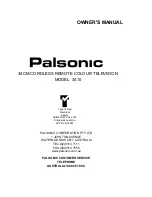
66
6. SMALL SIGNAL PANEL
MG5.1E
6.10 Protection structure
Personal notes
Protections via HOP
The following protections are present:
•
LDP (line deflection protection). Two protection lines come
in on pin 5 of the HOP (fig 6-25):
–
Flash detection is detected via D6341 and TS7341. In
case of a flash pin 5 becomes high and the Horizontal
Drive (HD) stops. The FLS-bit is set in a register of the
HOP. A flash is only shortly present. With a “flash
refresh” (see flowchart fig 6-24) the FLS-bit is reset and
the line output stage is started again via a slow start
(chapter 12)
–
Also to pin 5 the E/W-protection is fed. The current in the
east/west stage is measured via R3483/R3484. In case
of fault condition the voltage is too high. This is sensed
at the +input of the op-amp IC7484 and compared with
1V. If the +input is above this 1V, then the E/W-
protection is activated. The output of the op-amp is fed
back via R3490/D6485 to keep the input high. The line
drive is stopped because the LDP input is high. Also in
this situation the FLS-bit is set, but after the refresh the
FLS-bit remains high. That makes the OTC conclude
that there must be a protection. This algorithm is also
illustrated in flowchart of figure 6-24.
•
Protections via the status register of the HOP. Every 200
msec the register in the HOP is read via I2C by the OTC. In
case of a protection via one the inputs to the HOP (VFB,
HFB) a bit is set to indicate what was wrong. In fig 6-26 the
circuitry related to VFB and HFB is visualised.
–
HFB (horizontal flyback). Missing horizontal flyback
pulses are detected via the HOP. Error code 71 is
generated and the TV switches into protection.
–
VFB (vertical flyback). Vertical flyback is also fed back
to the HOP. The picture will be blanked if the vertical
flyback pulses are missing. This is done to prevent the
picture tube from burning in. The set will go into
protection after one second.
















































